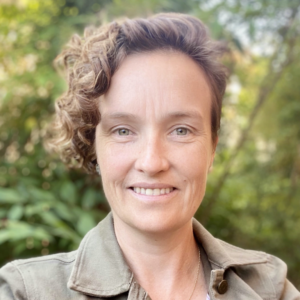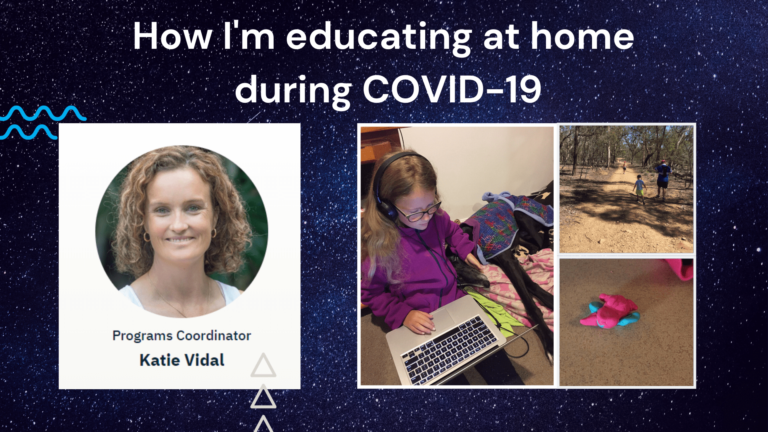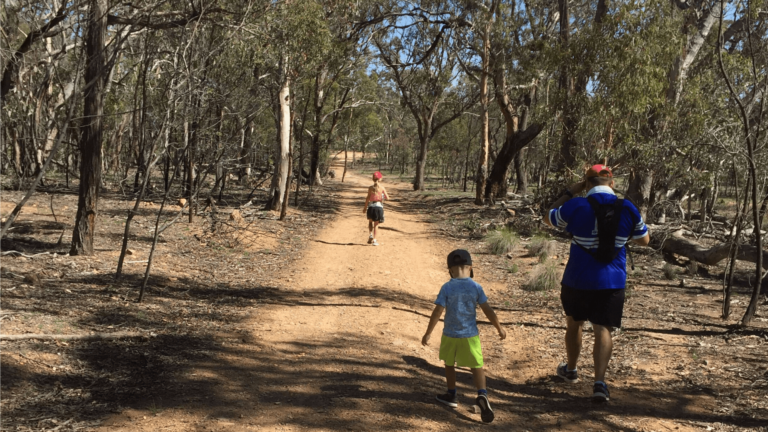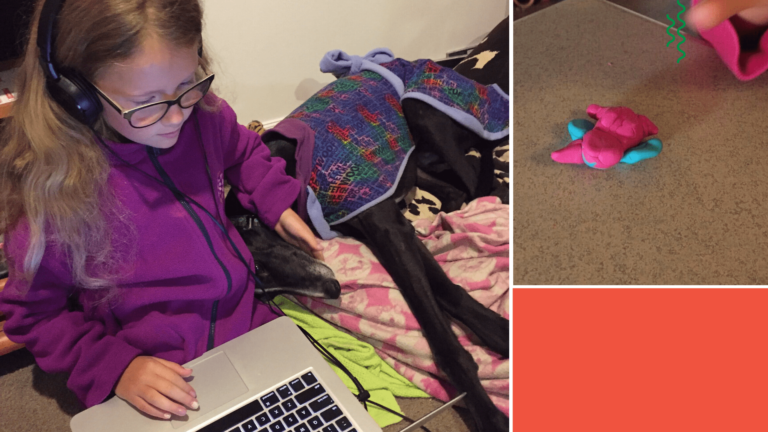Main Menu


Hi! I’m Katie Vidal, I’m a mother to three busy children and a teacher on a casual basis. Like you, I’m also in a state of lockdown and, probably like you, COVID-19 has led to a fairly significant lifestyle change!
You may have come across me if you’ve ever booked a She Maps Program, I do a lot of work managing programs and helping to create the experiences and resources that She Maps teachers and students love so much.
But for this article, I’m coming to you as a mother trying to parent, teach, entertain, cook, soothe, create a unique quarantine birthday party (it involved a lot of video messages from a lot of kids and family friends and it went over a treat), and much more that I wish we could all put on our CVs!
Today, I’m here to show you how I’m working with the She Maps daily online STEM show, Live in Orbit — a really engaging class that kids tune into, interact with, and do assigned activities after.
We live in Canberra, where we’ve been for the last few years, although we’ve lived in 3 different states/ territories and 3 countries due to my husband’s work with Department of Defence. His job description has changed in response to COVID-19 and his working hours have changed.
As a result, I’ve taken on the role as the primary caregiver to my children. I’m also in charge of their learning, keeping them active and sane, as well as myself sane. I manage to squeeze in a couple of hours of work on She Maps each day (some days are better than others).
Lockdown life has been going okay – like a lot of people, I’m very aware of the fortunate position I’m in. But also, like a lot of people, there have been the not-so-great moments too where consumption of chocolate or a nice glass of wine or even some deep breathing alone in the bedroom have been employed.
That’s why I decided to share what I’ve been up to educating at home with Live in Orbit. This is definitely not a ‘copy my way of doing things’ blog! Every parent I’ve talked to is struggling with juggling these multiple hats and sometimes it’s nice to see the behind-the-scenes of another parent’s thought process as they navigate this.
So, here we go.
The kids’ schools have been fantastic. I’ve got a 6-year-old son, a 10-year-old daughter and a 12-year-old son who has just started high school — the full schooling spread!
Their teachers put their tasks for the week in Google Classroom and they have a role call, homeroom-style call with their teachers every morning. There was a couple of weeks at the start where teachers hadn’t transitioned and it was largely up to us to figure out what to do — that’s actually when I started using Live in Orbit to give them structure — but more on that in a second.

Writing this made me think about a few things I’ve learned, or at least cemented in my mind, from this whole experience:
We always talk about structure being really important for kids but when everything’s thrown into disarray, you really get why it’s so important! My kids think about time quite differently at their different stages. Reflecting on this with my husband has definitely helped me understand them a bit better — and help to keep them happier.
This one is a total relief when you let it settle in. They’re never going to see you that way and what you can teach them is so often ‘off the books’, which leads me to…
As most parents know, setting expectations is a constant balancing act between not being overbearing and placing pressure, while also encouraging our kids to be their best selves.
Being ok with being less than perfect and not being in control of a situation is a reality of living in the world right now. And actually, sharing my imperfect world with my kids has really connected us. When my son said the other day that he was missing his friends, I let him know that I’m having a hard time with missing my friends too. It registered with him and anarchy didn’t ensue just because I shared a tough experience with him.
So, the Vidal family is getting there — slowly, but surely. But now, onto educating with Live in Orbit.
This is the part where I try and convince you I’m not totally biased because I work for She Maps. And I swear, I’m really not. Although, admittedly, it was much easier to take the plunge and try something new when it’s right in front of you.
Here’s how Live in Orbit works in the Vidal household:
When we started out with Live in Orbit, we had zero structure and Live in Orbit started at 9am. That was a done deal for me to be honest. Being able to get the kids engaged at the start of the day was a much-needed kickstart (for all of us!). After they finished the Live in Orbit task, it felt pretty natural to head into a normal (ish) daily routine.
Usually, a Live in Orbit lesson took about 60 minutes by the time the kids watched and interacted with the show and then completed the task afterwards. The task was flexible enough that I could have made it last all day but I found the one hour spurt was enough — especially because kids don’t always know how to manage their energy and pace themselves to tackle the whole day.
Live in Orbit works really well for a lot of age groups. I find it works best for my two primary age kids. That’s actually perfect because my eldest son is fairly good at working autonomously and using a lot of apps and social technology to keep himself occupied. He still watches presentations but he’ll pick them based on things that interest him.
Conversations in our house have been great when the kids are engaged with Live in Orbit. Every STEM expert is doing something amazing in their field in real life, which is honestly so inspiring to me as an adult, and it absolutely captivates my kids.
They each have different lessons that they are really fascinated with. My eldest loved physiotherapist, David and Kay Joyce, talking about the physics of exercise and how it relates to science. He’d never thought of exercise that way and it quite literally opened up a whole new way of thinking. He also signed in to watch rugby league player Mark Mclinden of Canberra Raiders fame talk about how STEM helped him to become the best player he could be.
My daughter really connects with the talks related to climate change and her enthusiasm goes well beyond the lesson. She’s been asking questions about how we as a family can change our lifestyle to think more seriously about our environmental impact. This has even come down to the type of groceries we buy and the water footprint that we create, thanks Shannon Babb.
The youngest is more about living in the moment and will all of a sudden start a discussion about how starfish have seawater flowing through their veins and that you can extract DNA from strawberries.

It’s been amazing to watch the news together as a family because it relates to STEM so much! From the pandemic to the effects around the world from staying inside and lowering the pollution.
When we watched an article about how people in India could see the Himalayas for the first time in decades because of the reduction in air pollution, it was like seeing all the cogs in their little brains furiously spinning as they connected all of the dots with what they’d been learning.
I’m really impressed that someone who studies geospatial science for a living can also teach mapping in an age-appropriate way to kids, and interact with them live on the subject, and keep a whole class lesson going, and provide a task that my kids are excited about doing afterwards. Hats off to them! They are even getting their own children involved in their presentations.
This has been an unexpected but highly appreciated benefit of educating with Live in Orbit. Because the lessons are ‘real’, as in they use real-life applications, it’s easy for my kids to decide which lessons they want to watch. The one about planes – yes; the one about weird algae stuff – yes — it’s great that their curiosity is given free rein. The Live in Orbit replays are great for this too.
All of my kids are now expected to be on a live Google Classroom meet with their teachers each morning when the Live in Orbit are being presented on Zoom. So I encourage the kids to pick from a schedule that’s released the week prior and watch it live if they are free, but they can also watch it another time if there’s a clash or if they change their mind and decide they do actually want to watch the one about spiders or the enchanted forests of Ecuador.
My kids go to school every day and get validation and approval for the work they do from the kids around them and from their teachers. It has come to my attention that I am a less exciting source of validation for them!
Every single day, Dr Karen Joyce does a shout out to the kids who did their She Maps homework and she shares it with kids from over 30 countries around the world as well as thousands of people through the She Maps social channels. That kind of acknowledgement is tough to beat — let’s just say my kids feel pretty chuffed when it happens!
Normally, at school, a guest speaker who is an expert on a subject is a big deal. They’d be organised to speak to the whole school and it was a really valuable experience for kids. With Live in Orbit, they’re not only getting a guest speaker every day, but the speaker also talks directly to them so they had a 1-on-1 connection. They can ask questions in the chat, do the task and have feedback on it. That doesn’t happen at school assembly!
It’s a lesson and there’s homework after and learning involved. But because it’s so engaging, my kids don’t associate it with schoolwork. It’s a great option to have when they’re bored or as a different activity at the end of their school day.
Ultimately, I’ve found using Live in Orbit with my kids easy because it’s edutainment and takes the pressure off me. There are so many resources out there but not all of them get my kids excited. Knowing that they’re sorted for an hour and that there’s variety going on – watching, interacting, thinking, creating – it’s great when I need time for myself.
It sets the day up for success. Sure, not every day is a wild success but we try and Live in Orbit makes it that little bit easier!
She Maps is Australia’s leading expert in drone and geospatial education.
She Maps assist schools with the purchasing of drones, school-industry created drone and geospatial teaching resources and highly supportive teacher professional development.
Ready to buy drones for your school? We are an authorised DJI reseller in Australia

Subscribe by email and never miss a blog post or announcement.

She Maps aims to bring much needed diversity and support to STEM. We do this by providing drone and geospatial programs to teachers and schools across the globe.
At She Maps we acknowledge the Traditional Custodians of Country throughout Australia and their connections to land, sea, and community. We pay our respect to their Elders past and present and extend that respect to all Aboriginal and Torres Strait Islander peoples today.
Aboriginal and Torres Strait Islander peoples are advised that this site may contain names, voices, or images of people who have passed away.
Learn the 6 Steps to Launching a Successful Drone and Geospatial Program at your School
Take our resources for a spin and join the thousands of teachers who love our ready-to-teach classroom materials. Try one of our complete units of work for free.

